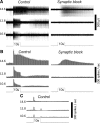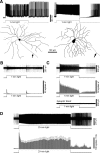A retinal ganglion cell that can signal irradiance continuously for 10 hours
- PMID: 22895730
- PMCID: PMC3432977
- DOI: 10.1523/JNEUROSCI.1423-12.2012
A retinal ganglion cell that can signal irradiance continuously for 10 hours
Abstract
A recently discovered type of mammalian retinal ganglion cell encodes environmental light intensity and mediates non-image-forming visual behaviors, such as the pupillary reflex and circadian photoentrainment. These intrinsically photosensitive retinal ganglion cells (ipRGCs) generate endogenous, melanopsin-based photoresponses as well as extrinsic, rod/cone-driven responses. Because the ipRGCs' light responses and the behaviors they control are both remarkably tonic, these cells have been hypothesized to be capable of irradiance detection lasting throughout the day. I tested this hypothesis by obtaining multielectrode-array recordings from ipRGCs in a novel rat eyecup preparation that enhances the regeneration of rod/cone photopigments. I found that 10 h constant light could continuously evoke action potentials in these ganglion cells under conditions that stimulated (1) only melanopsin, (2) mainly the rod input, and (3) both intrinsic and extrinsic responses. In response to a 10 h stimulus with gradual intensity changes to simulate sunrise and sunset, ipRGC firing rates slowly increased during the "sunrise" phase and slowly decreased during the "sunset" phase. Furthermore, I recorded from putative ipRGCs of melanopsin-knock-out mice and found that these cells retained the ability to respond in a sustained fashion to 20 min light steps, indicating that melanopsin is not required for such tonic responses. In conclusion, ipRGCs can signal light continuously for at least 10 h and can probably track gradual irradiance changes over the course of the day. These results further suggest that the photoreceptors and ON bipolar cells presynaptic to ipRGCs may be able to respond to light continuously for 10 h.
Figures





Similar articles
-
Melanopsin and the Intrinsically Photosensitive Retinal Ganglion Cells: Biophysics to Behavior.Neuron. 2019 Oct 23;104(2):205-226. doi: 10.1016/j.neuron.2019.07.016. Neuron. 2019. PMID: 31647894 Free PMC article. Review.
-
Dopaminergic modulation of ganglion-cell photoreceptors in rat.Eur J Neurosci. 2012 Feb;35(4):507-18. doi: 10.1111/j.1460-9568.2011.07975.x. Epub 2012 Feb 5. Eur J Neurosci. 2012. PMID: 22304466 Free PMC article.
-
C-terminal phosphorylation regulates the kinetics of a subset of melanopsin-mediated behaviors in mice.Proc Natl Acad Sci U S A. 2017 Mar 7;114(10):2741-2746. doi: 10.1073/pnas.1611893114. Epub 2017 Feb 21. Proc Natl Acad Sci U S A. 2017. PMID: 28223508 Free PMC article.
-
The rat retina has five types of ganglion-cell photoreceptors.Exp Eye Res. 2015 Jan;130:17-28. doi: 10.1016/j.exer.2014.11.010. Epub 2014 Nov 18. Exp Eye Res. 2015. PMID: 25450063 Free PMC article.
-
Strange vision: ganglion cells as circadian photoreceptors.Trends Neurosci. 2003 Jun;26(6):314-20. doi: 10.1016/S0166-2236(03)00130-9. Trends Neurosci. 2003. PMID: 12798601 Review.
Cited by
-
Prefrontal cortex neurons encode ambient light intensity differentially across regions and layers.Nat Commun. 2024 Jun 29;15(1):5501. doi: 10.1038/s41467-024-49794-w. Nat Commun. 2024. PMID: 38951486 Free PMC article.
-
Efficacy of biologically-directed daylight therapy on sleep and circadian rhythm in Parkinson's disease: a randomised, double-blind, parallel-group, active-controlled, phase 2 clinical trial.EClinicalMedicine. 2024 Feb 10;69:102474. doi: 10.1016/j.eclinm.2024.102474. eCollection 2024 Mar. EClinicalMedicine. 2024. PMID: 38361993 Free PMC article.
-
Melanopsin and the Intrinsically Photosensitive Retinal Ganglion Cells: Biophysics to Behavior.Neuron. 2019 Oct 23;104(2):205-226. doi: 10.1016/j.neuron.2019.07.016. Neuron. 2019. PMID: 31647894 Free PMC article. Review.
-
Tangled up in blue: Contribution of short-wavelength sensitive cones in human circadian photoentrainment.Proc Natl Acad Sci U S A. 2023 Jan 10;120(2):e2219617120. doi: 10.1073/pnas.2219617120. Epub 2023 Jan 4. Proc Natl Acad Sci U S A. 2023. PMID: 36598954 Free PMC article. No abstract available.
-
Sinusoidal analysis reveals a non-linear and dopamine-dependent relationship between ambient illumination and motor activity in larval zebrafish.Neurosci Lett. 2021 Sep 14;761:136121. doi: 10.1016/j.neulet.2021.136121. Epub 2021 Jul 19. Neurosci Lett. 2021. PMID: 34293416 Free PMC article.
References
-
- Berson DM, Dunn FA, Takao M. Phototransduction by retinal ganglion cells that set the circadian clock. Science. 2002;295:1070–1073. - PubMed
-
- Dacey DM, Liao HW, Peterson BB, Robinson FR, Smith VC, Pokorny J, Yau KW, Gamlin PD. Melanopsin-expressing ganglion cells in primate retina signal colour and irradiance and project to the LGN. Nature. 2005;433:749–754. - PubMed
-
- DeVries SH, Schwartz EA. Kainate receptors mediate synaptic transmission between cones and ‘Off’ bipolar cells in a mammalian retina. Nature. 1999;397:157–160. - PubMed
Publication types
MeSH terms
Substances
Grants and funding
LinkOut - more resources
Full Text Sources
Molecular Biology Databases
Miscellaneous
